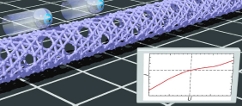The transport properties, work functions, electronic structure, and energetic stability of boron nanotubes with different lattice structures, radii, and chiralities are investigated theoretically. As the atomic structure of boron nanotubes and the related sheets is still under debate, three probable structural classes (nanotubes derived from the α-sheet, the buckled triangular sheet, and the distorted hexagonal sheet) are considered. For comparison with recent transport measurements [J. Mater. Chem. 20, 2197, (2010)], the intrinsic conductance of ideal nanotubes with large diameters (D ≅ 10 nm) is determined. All considered boron nanotubes are highly conductive, irrespective of their lattice structures and chiralities, and they have higher conductivities than carbon nanotubes. Furthermore, the work functions of the three sheets and the corresponding large-diameter nanotubes are determined. It is found that the value of the nanotubes obtained from the α-sheet agrees well with the experiment. This indirectly shows that the atomic structure of boron nanotubes is related to the α-sheet. The energetic stability of nanotubes with diameters > 2 nm approaches that of the corresponding boron sheets, and α-sheet nanotubes are the most stable ones. However, for smaller diameters the relative stabilities change significantly, and for diameters < 0.5 nm the most stable structures are zigzag nanotubes of the buckled triangular sheet. For structures related to the distorted hexagonal sheet the most stable nanotube is discovered to have a diameter of 0.39 nm.

The transport properties, work functions, electronic structure, and energetic stability of boron nanotubes with different lattice structures, radii, and chiralities are investigated theoretically. As the atomic structure of boron nanotubes and the related sheets is still under debate, three probable structural classes (nanotubes derived from the α-sheet, the buckled triangular sheet, and the distorted hexagonal sheet) are considered. For comparison with recent transport measurements [J. Mater. Chem. 20, 2197, (2010)], the intrinsic conductance of ideal nanotubes with large diameters (D ≅ 10 nm) is determined. All considered boron nanotubes are highly conductive, irrespective of their lattice structures and chiralities, and they have higher conductivities than carbon nanotubes. Furthermore, the work functions of the three sheets and the corresponding large-diameter nanotubes are determined. It is found that the value of the nanotubes obtained from the α-sheet agrees well with the experiment. This indirectly shows that the atomic structure of boron nanotubes is related to the α-sheet. The energetic stability of nanotubes with diameters > 2 nm approaches that of the corresponding boron sheets, and α-sheet nanotubes are the most stable ones. However, for smaller diameters the relative stabilities change significantly, and for diameters < 0.5 nm the most stable structures are zigzag nanotubes of the buckled triangular sheet. For structures related to the distorted hexagonal sheet the most stable nanotube is discovered to have a diameter of 0.39 nm.
